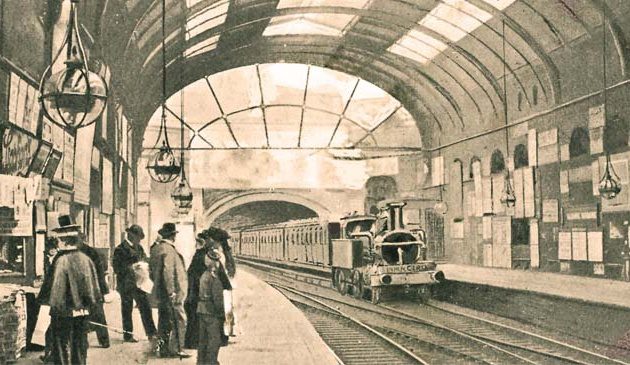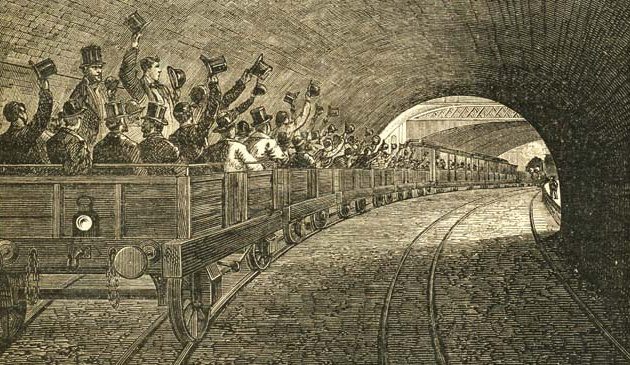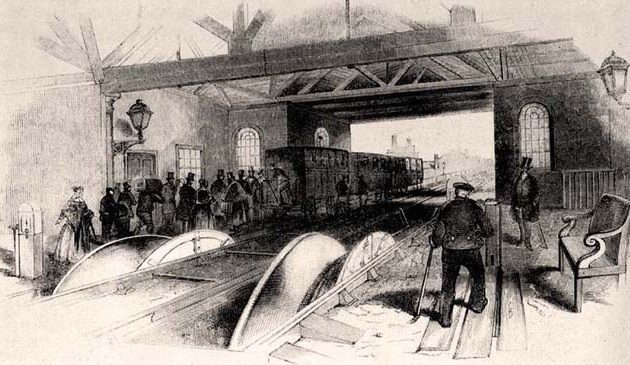London’s first railway

The London & Greenwich Railway ran along a four-mile long viaduct from Tooley Street on the south side of London Bridge. Much of its route was still rural as can be seen here where the line passed over Spa Road at Bermondsey.
The great invention of the Victorian era was the railway. The main stimulus for its earliest development was the ability to move freight, particularly coal, so it was late to arrive in London compared with the industrial North of England. Most of the first passenger railways departing from the capital were created to carry people far around the country and had little impact on the city until the 1860s. But London’s first railway was a more local route.
The idea of transporting goods and materials in wagons along a track gradually evolved over an extended period. In the 17th century tracks were simply wooden planks. In the following century they were replaced by wooden rails and larger wagons with iron wheels were pulled by horses. The first iron rails were introduced in around 1790.
The claim to be the first railway to operate on iron rails in the London area, perhaps also the first public railway anywhere in the world, can be made by the Surrey Iron Railway. It was authorised by an Act of Parliament in 1801, the first such Act for a railway. The line opened in stages between 1802 and 1803 along the Wandle Valley, from Frying Pan Creek on the Thames at Wandsworth, via Merton, Mitcham and Waddon, to Pitlake Meadows at Croydon. Horse-drawn trains of ten wagons transported coal, building materials, and farm produce on a narrow-gauge, double-tracked line. The company charged a toll for carriers to run their trains on the tracks and the line remained open until 1846.
As the Surrey Railway was opening, the Cornish engineer Richard Trevithick was experimenting with static steam engines for pumping water from mines, based on the earlier machines produced by Matthew Boulton and James Watt. In 1801 he created the ‘Puffing Devil’ steam road vehicle but the surfaces of roads at that time were too poor for such a device to be successful. Drawings exist of a machine created for Trevithick by the Coalbrooke Iron Works to run on rails, which was probably the world’s first steam railway locomotive. Further experiments continued and in 1808 Trevithick publicised his work by creating the first passenger train. A locomotive named ‘Catch Me Who Can’ ran around a short circular ‘steam circus’ track at Euston Square in London. Passengers were charged one shilling for the novelty of travelling at up to 12 miles per hour. Unfortunately, the weight of the engine was too great for the rails and the ride closed after two months.
By that time railways had for long been used to carry coal or other materials for mines in the north and south-west of England, with wagons pulled by horses. From around 1812 pioneering engineers were creating new steam locomotives to replace horses. The earliest was the Stockton & Darlington Railway, which began operating in 1825 to transport coal from mines in the north-east of England.
A proposal had been promoted in 1824 for a passenger and goods railway from London across Kent to Canterbury, via Greenwich, Woolwich, Gravesend, and Chatham, with trains pulled by ‘locomotive machines’. The engineer was to be the canal and bridge builder Thomas Telford, but investors were unwilling to put up the necessary million pounds on a still unproven concept. A six-mile line did open between Canterbury and Whitstable on the North Kent Coast: the ‘Crab and Winkle line’. An attempt was made to pull wagons on that route using George Stephenson’s ‘Invicta’ locomotive but it had insufficient power to climb the steep hills so the line reverted to cable haulage using stationary steam engines.
But in September 1830 the Liverpool & Manchester opened, the world’s first passenger railway to connect two cities, with trains pulled by steam locomotives operating in each direction on two lines.
This idea of a passenger railway caught the attention of George Thomas Landmann. He had retired in 1824 as an officer in the Royal Engineers after a distinguished career, latterly in Canada where he had built forts to defend against an American invasion. In 1831 Landmann and George Walter made a proposal to create a 3½-mile railway from Tooley Street, Southwark on the south side of London Bridge to London Street, Greenwich. That same year the rebuilt London Bridge had opened, making it easier to cross the Thames into the City. Thus a railway to Southwark would be convenient for those travelling to and from London and the naval dockyards at Deptford, as well as the maritime town of Greenwich to which Londoners were attracted by its neighbouring park.
The Thames steam ferries and stage coach companies objected to the proposed railway, as did George Shillibeer, the originator of London’s first omnibuses. Nevertheless, it was sanctioned by Act of Parliament in May 1833. Importantly, the Act stipulated that the line should be the only one to enter the capital from the south.
There was scepticism regarding the financial viability of the enterprise, with some saying it would need to be extended to Dover before there would be sufficient passengers. Nevertheless, £400,000 was raised in £20 shares, later rising to £600,000. Negotiations then took place with 500 separate freeholders over whose land the railway would pass. Buildings in Southwark and Bermondsey, many of them slum dwellings, had to be demolished.


